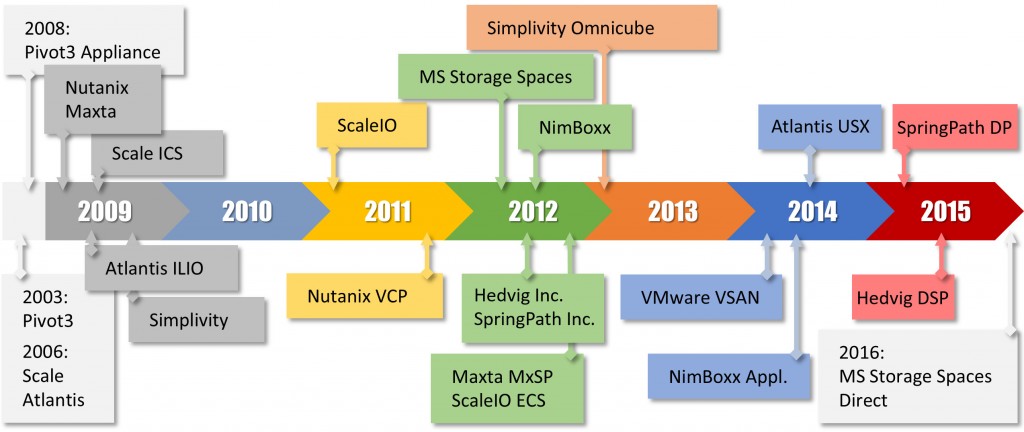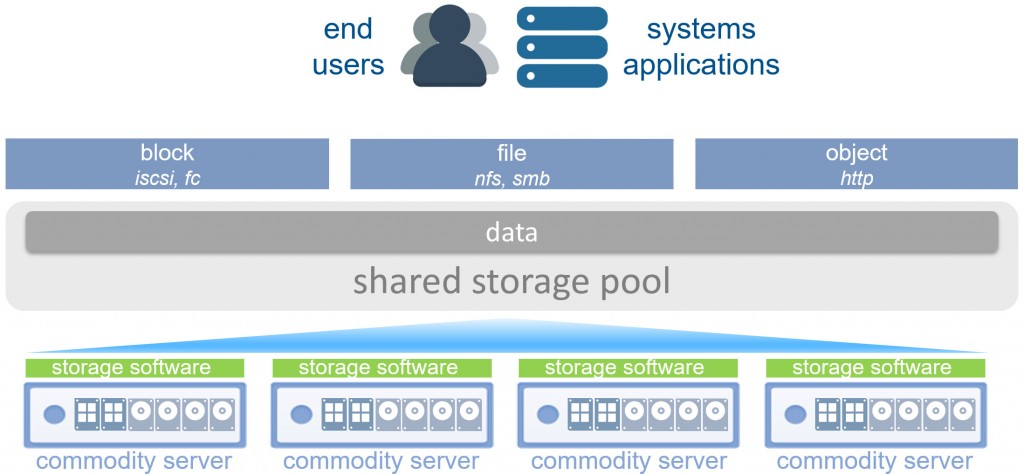The age of SDS & HCI (by Herman Rutten)
I’ve been working in the IT industry since 1999 and not long after we all made the plunge into the new millennium, I was introduced to a thing called “shared storage”. I recall they were HP XP512’s, high-end storage systems that were very robust but at the same time quite hard to manage. Ever since that first encounter I haven’t left the world of datacenters with their compute, storage, virtualization, disaster recovery, backup/restore and data management. Much has changed in the last 15 years. In my consulting job I’ve come across a lot of different storage solutions, been advising on optimisation and renewals while aligning to business requirements, and have been solving quite some interesting and complex storage performance problems.
Today a new comparison is added to WhatMatrix: SDS & HCI (link)
Here you’ll be able to compare products like Nutanix XCP, SimpliVity DVP, VMware VSAN and Atlantis USX as they evolve ….
A few years back the industry started to turn another corner when it comes to the general approach to storage. Today, it is evident that a new age has dawned, with Software Defined Storage (SDS) and Hyper-Converged Infrastructure (HCI) as its front runners. However, from the beginning there has been an ongoing debate about the very meaning of the term. The entire discussion essentially boils down to the question: When does something really qualify as “Software Defined Storage” (SDS)… ?
So what exactly is Software Defined Storage (SDS)?
Looking from an objective definition standpoint, in order for a solution to qualify as ‘true’ SDS, it has to have at least these 3 main characteristics:
- The software is designed to run on commodity server hardware and makes use of the available resources therein.
- The solution aggregates physical storage capacity* from separate systems into a single shared storage pool.
- The solution offers a broad set of storage functionality (services) comparable to traditional hardware defined shared storage systems.
*Storage capacity can be but is not limited to internal DRAM, Ultra DIMMs, PCIe cards, harddisks.
The first two ‘rules of engagement’ effectively exclude the traditional shared storage solutions from the conversation, because they are built on fixed controllers plus most of the time have external disk shelves to aggregate a storage pool from.
The figure below is a high-level depiction of the Software Defined Storage (SDS) concept.
How does Hyper-Converged Infrastructure (HCI) fit in?
If you apply the above definition, software-only solutions like VMware VSAN and Atlantis USX successfully qualify, as do hardware-software combinations like Nutanix and SimpliVity. This effectively means that SDS is a broader term with two general ways in which to acquire it:
- Build-Your-Own (BYO) / Choose-Your-Own (CYO) = software-only solution + commodity server hardware of your choice as long as it complies to the software vendor’s HCL and/or minimum hardware specs.
- Hyper-Converged (HCI) / SDS appliances = software solution + commodity server hardware offered as a single package (pre-defined building blocks that are ready-to-go / turnkey).
You could very well advocate a third way to acquire SDS:
- Reference Architecture (RA) = software-only solution + server hardware of your choice that follows the software vendor’s exact guidelines for a certain hardware configuration (also pre-defined building blocks, but still BYO/CYO when implementing this)
The difference between HCI and RA being, that HCI makes the software vendor the single point-of-support for the entire solution once acquired, plus there are most often additional tools provided to quickly deploy the infrastructure. With RA, like with BYO/CYO, the software support and hardware support are split between the software vendor and the hardware vendor. Also the ‘ready-to-go / turnkey’ aspect is missing.
How is the SDS & HCI market evolving?
The current market trend is, that most HCI vendors (eg. Nutanix, SimpliVity) are partnering with more and more server hardware vendors to provide customers with more freedom of choice when it comes to hardware, effectively trying to close this gap with software-only SDS offerings. At the same time most software-only vendors (eg. Atlantis, VMware) are partnering with server hardware vendors in order to provide turnkey infrastructures to customers, effectively trying to close the gap with their hyper-converged siblings.
These market trends actually support both the broad definition of SDS as well as the fact that we decided to have one comparison category incorporating both SDS & HCI (marked respectively when you select the products for comparison). Bottom line being: the engine that drives these solutions and provides all the intelligent functions, is embedded in software, whether it is incorporated in BYO/CYO, HCI or RA.
Going forward we might decide to split the comparison further out but in the meantime it will allow people to compare products from either approaches, identify the functional differences between the two (pay attention to the sub category scores in the matrix), as arguably often either of the two could be a suitable approach for a certain use case.
Introducing a New Comparison Category
As stated, each of the listed products has pros and cons for specific deployment scenarios. There are many SDS & HCI products out there today and there are bound to be more on their way. This calls for some much needed insight and WhatMatrix is delivering just that.
Today a new category is added to WhatMatrix: SDS & HCI. Here you’ll be able to compare products like Nutanix XCP, SimpliVity DVP, VMware VSAN and Atlantis USX as they evolve. We’re aiming to expand the SDS & HCI products on the list, so stay tuned for more information. For now check out the current selection and please share with us what you think, both the good and the bad. Enjoy!
Herman.
P.S. Please feel free to contact me if you have any feedback or feel that a certain product should be added to the matrix … thanks!

Herman Rutten

Latest posts by Herman Rutten (see all)
- StarWind HyperConverged Appliance enters the WhatMatrix - December 3, 2019
- SDS & HCI Updates: Nutanix, NetApp, vSAN, HPE - September 3, 2019
- WhatMatrix adds Scale Computing HC3 to SDS/HCI Lineup - June 5, 2019






